NEW CANNAN, CT—Six. That is the number of paintings the renowned architect Philip Johnson believed should be viewed at one time. “That’s as much as you can take in…” he has said, “it’s all you can register.”
So what better way to present “Julian Schnabel: ‘Paintings that I hope Philip and David would like'" than in groups of six? So thought the exhibition organizers at the Glass House, Johnson's serene 49-acre estate where he and his partner, David Whitney, spent time together for more than four decades. The centerpiece of the estate is Johnson's iconic glass-walled residence, Glass House. The exhibition can be found in the semi-underground Painting Gallery—one of the property’s 14 structures—where the couple housed their permanent art collection.
Johnson (1906-2005) designed the Painting Gallery to feature three sets of two-sided panels constructed like giant poster racks. Together they hold 42 paintings, but at any given time, only six are visible. “Julian Schnabel” will be displayed in three rotations of the panels, each comprised of six large-scale paintings featuring a different period in Schnabel’s prolific career. Schnabel is an internationally exhibited painter and sculptor and an Oscar-nominated filmmaker who lives and works in Manhattan and Montauk. He is the second most represented artist in the Glass House painting collection (the first is Frank Stella). He also had a personal hand in curating the exhibition.
“Both Johnson and Whitney were passionate about Julian’s work,” said Ilene Shum, the Glass House’s curator, collections manager and organizer of the show. “They started collecting his work in 1990 and continued until their deaths in 2005.”
Rotation 1, currently on view through June 5, 2017, is “Wax Paintings from the 1970s.” The work was made before Schnabel’s first solo exhibition at Mary Boone Gallery in 1979 and his subsequent rise to prominence. These early and rarely seen works, gathered from private collections, reveal the artist’s search for a visual vocabulary with repeated motifs of male torsos and branching crack-like lines. Perhaps most notable is Schnabel’s experimentation with the canvas’s surface, in some spots carved out in rectangular notches, in others built up with modeling paste, wax, plaster, joint compound and wire mesh.
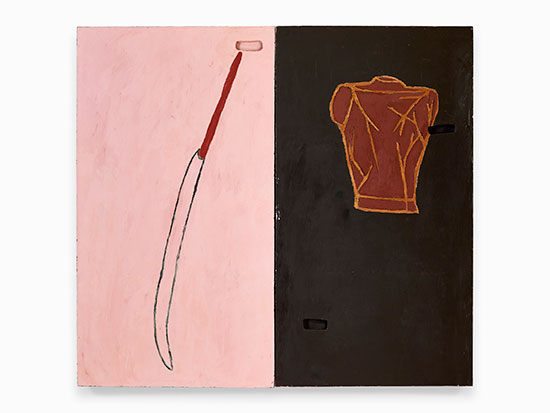
"Vallensasca, Italian Hero" by Julian Schnabel, 1979. Oil, wax, modeling paste on canvas, 96 x 105.5 inches. Hall Collection. Photo: Andy Romer. Courtesy of Glass House.
.
The oldest work in Rotation 1 is from 1975: Jack the Bellboy / A Season in Hell, in which a faceless white head floats amid painted hatch marks, raised horizontal dashes and blocky gouges. Schnabel’s aim was to depict an old door rife with history. In his 1987 memoir, “CVJ: Nicknames of Maitre D's & Other Excerpts from Life,” written when he was just 36, Schnabel described the painting as the “first that went astray from the predetermined format of a stretched canvas. … It looked like it had been exhumed from the world and then drawn on.”
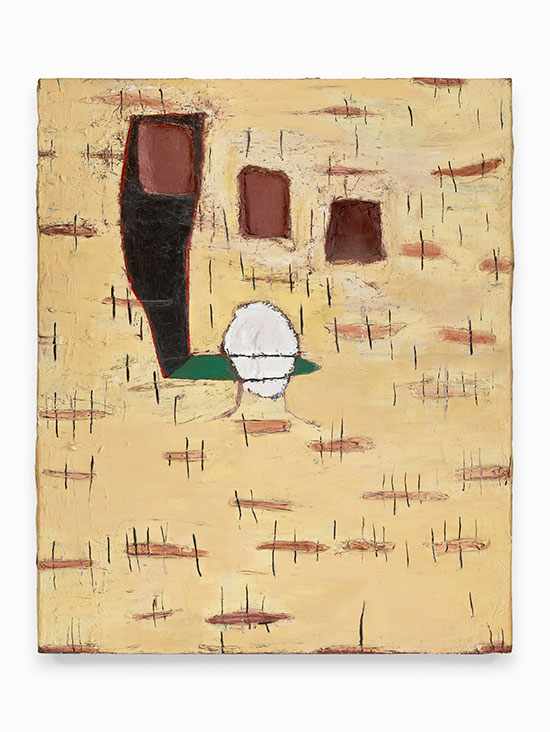
"Jack the Bellboy / A Season in Hell" by Julian Schnabel, 1975. Joint compound, Rhoplex, oil, plaster, wire mesh on canvas, 72 x 48 inches. Private Collection. Photo: Andy Romer. Courtesy of Glass House.
.
Shum called Jack the Bellboy “pivotal” in sparking Schnabel’s soon-to-come incorporation of all sorts of objects “exhumed from the world” – from broken plates, to photographs, to Kabuki theater backdrops. “He was trying to create the sense of time passing,” she said, “and he realized that he didn’t have to be literal, that found objects already had stories, they already had histories built into them.”
Rotation 2, “Paintings after 2000,” will be installed from June 8 to July 10, 2017. The exhibition showcases six pieces from three recent bodies of work, on loan from Schnabel’s personal collection. From the "Weather Painting" series, the 11-foot tall Weather Paintings IB and Weather Paintings IIB are photographic prints of Schnabel’s abstract paintings, their swirling shades of purple evoking aerial shots of stormy weather.
Two works from "Nothing Paintings" series feature compositions with words and forms painted on a sideways print of a found photograph of an elephant. They illustrate Schnabel’s longstanding interest in combining text and image and his continued use of found materials. Found material is integral to Landscape Paintings I and Landscape Paintings II, made with ink washes, again in hues of purple, on store awnings brought back from Mexico. The works are part of Schnabel's "Landscape Painting" series.
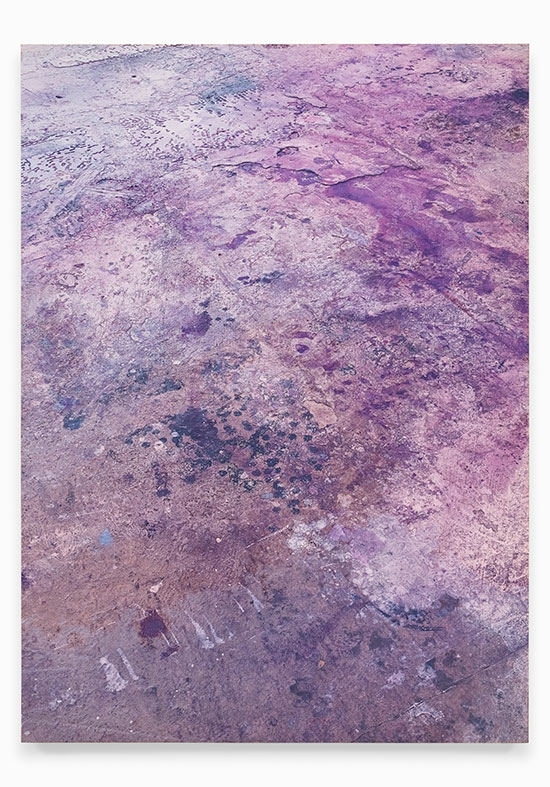
"Weather Paintings IB" by Julian Schnabel, 2015. Inkjet print, ink on polyester, 132 x 96 inches. Courtesy of the artist. Photo: Andy Romer.
.
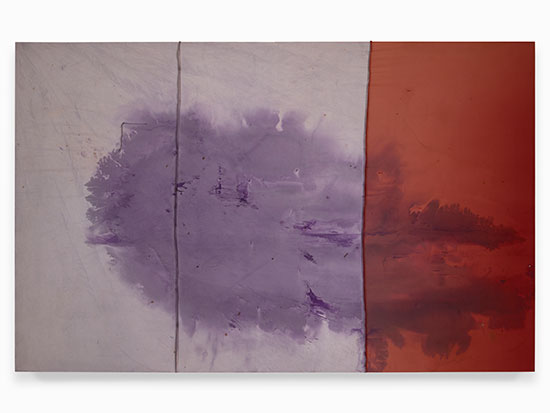
"Landscape Paintings II" by Julian Schnabel, 2016. Ink on found fabric, 104 x 165.25 inches. Courtesy of the Artist. Photo: Andy Romer.
.
The works in Rotation 3, “Paintings from the 1980s & 1990s” complete the linked exhibition and will be shown from July 13 to August 14, 2017. The art was selected from the Glass House's permanent collection and personally collected by Philip Johnson and David Whitney (1939-2005). All are boisterous pieces filled with explosions of color and whimsical forms, some with text, all with found objects. They include Untitled (Bingo), Untitled (Los Besos de tu Amor), Untitled (Boni Lux) and La Banana e' Buona.
.
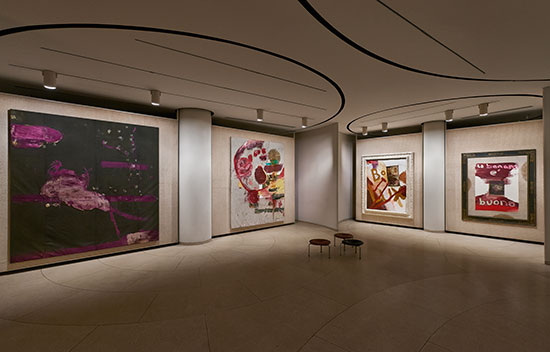
From Rotation 3: “Paintings from the 1980s & 1990s” by Julian Schnabel. Left to Right: "Untitled (Bingo)," "Untitled (Los Besos de tu Amor)," "Untitled (Boni Lux)" and "La Banana e' Buona." Photo: Andy Romer. Courtesy of Glass House.
.
In addition to the exhibition, five of Schnabel’s Soundings in Fathoms and Feet map drawings, markings in deep reds made on old nautical maps, made in 2006, will remain on view throughout the three Rotations. The works are installed in the Painting Gallery entryway. Even before visitors enter the Painting Gallery, Schnabel's work can be seen. His powerful 30-foot-long bronze sculpture Ozymandias is permanently sited along the pathway between the Painting Gallery and the Sculpture Gallery.
Julian Schnabel took a hands-on approach to the exhibition’s organization, selecting each piece and assisting with its installation. To assemble Rotation 1, Shum said that before she took over, he made the initial calls to the lenders. “And when I say ‘he,’” she said, “I mean Julian, not his studio.”
Perhaps Schnabel’s zeal resulted from his desire to pay tribute to Johnson and Whitney, as he has paid tribute with his art to many who have influenced him. Schnabel was enthusiastic about the concept of the rotations because he recognized that was how Johnson and Whitney enjoyed their artwork. And the show’s full title suggests both appreciation and deference.
Despite their different focuses, Schnabel shares with Johnson a fascination with ruins and the effects of weather and the passage of time. Shum noted a melancholia in Schnabel’s work. “For me there is an elegiac quality,” she said. “With quiet reflection, one cannot help but feel the gentleness and longing that are embedded in these pieces, which belie the bold gestures on the canvas.”
Each one, she said, is “an affirmation of life and human emotion.”
_______________________________
BASIC FACTS: “Julian Schnabel: ‘Paintings that I hope Philip and David would like’” opened on May 1 and runs through August 14, 2017 at the Glass House. Rotation 1: “Wax Paintings from the 1970s” closes June 5, 2017. Rotation 2: “Paintings after 2000” will run June 8 to July 10, 2017. Rotation 3: “Paintings from the 1980s & 1990s” is on view from July 13 to August 14, 2017. For details on the exhibition, click here.
Also on view for the season is “Robert Indiana: One Through Zero,” 10 six-foot-tall corten steel number sculptures installed on the Glass House’s lower field. The installation is on view from May 15 through November 30, 2017.
The Glass House is open May through November. Visits are by tour only with advance reservations required. Glass House is located at 199 Elm Street, New Canaan, Connecticut 06840. www.theglasshouse.org.
_______________________________
Copyright 2017 Hamptons Art Hub LLC. All rights reserved.
